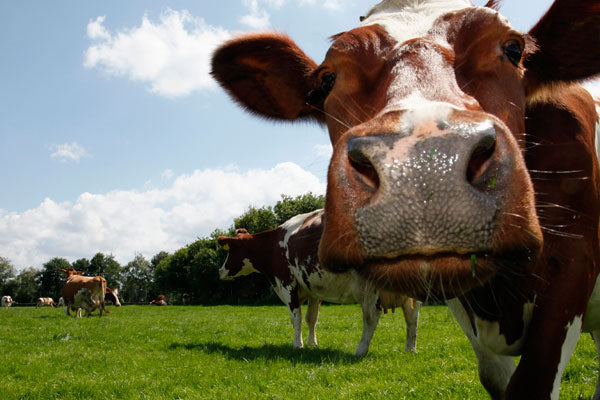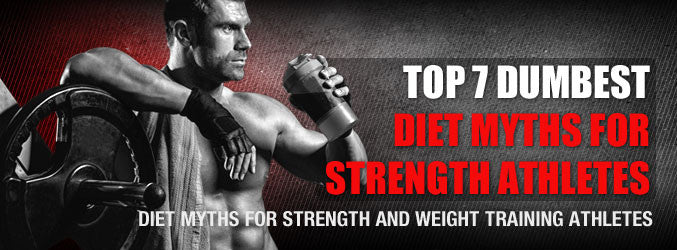
Fat loss is a business. And a very good business, at that. Without a doubt, millions upon millions of dollars have been earned over the past century by those with ideas and products/services to offer, and those with disposable income and a desire to grow leaner and more ripped. With so many offerings on the market, many not-so-true impressions have reached the public, which need to be addressed. Before you sabotage your efforts to grow leaner – while maintaining your levels of muscle mass and strength – Let’s break down the seven dumbest diet myths for strength and weight training athletes.

Whole milk should be avoided
Due to its sugar and fat content, many strength training athletes tend to avoid keeping milk in their nutritional plans. “Milk if for babies, Arnold drinks beer!” may be a Schwarzenegger quote that is often quoted, but shouldn’t really be applied, in the case of those looking to remain strong while keeping their strength levels high. Milk is packed with protein, useful fats, and carbs for training. And it’s a natural food. Milk’s level of GH is not negligible at all. If you’re looking to maintain muscle while growing leaner, you should consider keeping whole milk in your diet plan.
A calorie is a calorie
A small order of French Fries from McDonalds may contain fewer calories than the steak and potatoes you have lined up for dinner. And the novice dieting strength trainer may just look at the caloric content and make the uneducated decision to opt for fewer calories, regardless of what exactly is on the plate in front of them. Consider factors such as nutrient content, digestibility, fat content, and macronutrient offerings before choosing the lower calories junk food. You are what you eat, and the body is a very efficient fat burning machine, when you give it the right tools for doing so. Eat junk and you’ll look like junk, with fat clinging to your body.

The scale is your #1 tool
Many strength athletes live by the scale. After all, they do spend most of their training days in the gym moving greater and greater amounts of weight. They record every poundage, and they use the bathroom scale for their own measurement as well, the gateway to them entering the powerlifting class they desire. Shedding body fat is a much more complex process, where shifting water levels can have the scale jumping all over the place. Weighing yourself ten times a day won’t change things, and certainly will not give you a reasonable understanding of the progress which you are making. Wiser is to use the mirror and tape measure, recording your progress every 48 hours immediately upon waking in the morning.
You’re going to get weaker
It’s long been traditional thinking that strength athletes who diet down in order to shed some body fat will lose a great deal of their strength. This leans toward the belief that their ‘bulk’ helps them move that heavy weight. However, real life practical examples have shown that athletes are often able to maintain lifting power up to 90% of their pre-diet capability. Look at Ronnie Coleman, two weeks out from the Mr. Olympia show, knocking out sets of 800 pound squats. It will require a higher personal bar to be set, and there is often a loss of confidence which accompanies the loss in bulk. But if you are able to remove yourself from that way of thinking, and your weight loss goals are sensible and gradual, your 1RM and 5RM capability should remain with 90% of your initial capability.
Goals don’t matter
Often, heavy strength lifters will just cut back a few calories and add a little bit of cardio, and expect their spare tire to disappear and a nice 6 pack of abs to emerge. This doesn’t really happen very often. Setting small goals, in the neighborhood of one pound of fat loss per week (living at a deficit of 500 calories each day) is a reasonable goal and one which most lifters would easily be able to accomplish with just a bit of added discipline at the dinner table.

The first diet is the easiest.
We all remember beginner’s gains, right? The first time we hit the gym, we saw great initial gains. The first year or two in the gym, we grew at an astounding rate. Then, as is the case for all lifters, as we grew closer to our physical limitations, the gains started to slow down. Using this reasoning, many lifters have started with the belief that their first diet will be the easiest as well, with the fat pounds peeling away most quickly the first time they diet. Nothing could be further from the truth. Experienced physique and bodybuilding competitors will agree – each subsequent competition diet is easier than the last. As you learn the fat-burning process and your body becomes accustomed to shedding body fat, your system becomes more and more efficient with shedding body fat. The first diet will likely be the most difficult. Be sure you’re taking detailed notes so that every possible lesson to be learned from this first foray into dieting can be unlocked!
Powerlifting and Bodybuilding are very similar
While it is true that both powerlifters and bodybuilders move some serious weight in the gym, using many of the same exercises, the similarities often stop there. Bodybuilders train to develop a balanced physique. They use toning-style, isolation exercises just as much as they use the heavy bulking movements, because balance and appearance is what matters to them. Powerlifters and Olympic lifters, on the other hand, don’t care too much about what the mirror tells them. They train for bulk, strength and power. When these two differing groups diet down, they often do so for different reasons using different goals and systems. Bodybuilders may train to be 5% body fat and ripped. Powerlifters often aim for 8-12% body fat and just plain leaner. Knowing which of these goals applies to you, and knowing that there is a very real difference, will help you in setting dieting goals and setting strategies in place.


